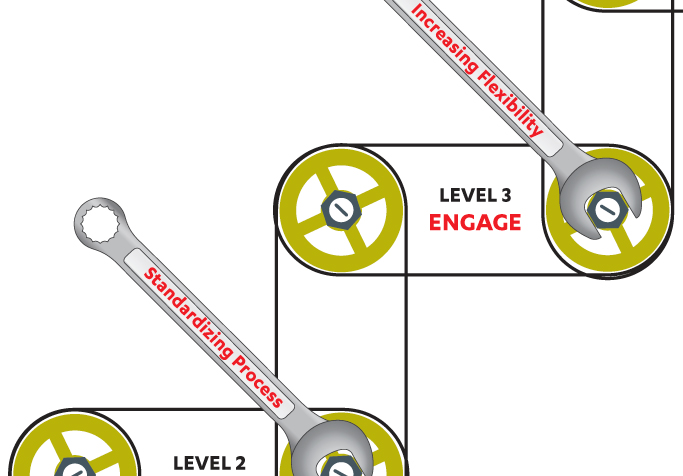I often describe the Level 2 hurdle as the highest and hardest to jump over. I’ve witnessed many an IT organization trip and fall, ending up with the proverbial skinned knee. The biggest tripping point is also the most common one: IT leaders are too accustomed to managing “noise.”
The inclination is often to do something radical—like a reorg—in a desperate attempt to stop the noise. Can you start with a reorganization? Sure. But this only works for organizations at a very high level of maturity, where processes are well instituted. Likewise, it can also work for organizations at a very low level of maturity that lack process rigor, but it will often result in sub-optimization. It’s not about moving things around, it’s about doing things differently.
Getting past Level 2 requires a three-pronged approach:
- Stop managing and start leading. This one’s not easy. Leaders at this level have worked very hard to get where they are. They’re confident in what they’re doing and they’re good at it. But when things start to change, the heroics stop mattering to the business and the noise begins, and it only gets louder as time passes. Often leaders make one of two decisions: 1) comply with whatever the business says, or 2) leave. But there is a third choice and it’s to lead, step up, break free from the rut of managing noise, and take the organization to a new place.
- Make processes efficient, then effective. Organizations at a Level 2 already have many processes that are installed. Their focus needs to be on making them more efficient, and then effective. Gaining efficiency comes through repeating the process numerous times and measuring the results to continuously improve. As every good designer/architect knows, “form follows function.” This principle, associated with modern architecture and industrial design in the 20th century, says that the shape of a building or object should be primarily based upon its intended function or purpose.
- Build trust. The underlying problem facing Level 2 IT organizations: Their internal clients don’t trust them. They lack credibility. It’s harsh, but it’s true. Level 2 organizations should invest in building a strong group of business relationship managers (BRMs, aka account managers). The ultimate sign of a strong BRM is when the business can’t tell if they’re talking to an IT person or another business person. So what constitutes a good BRM? What are the core competencies every BRM needs?
- Business acumen
A good BRM should speak the business’ language and be effective at translating business needs into IT demand and vice versa. - Communication skills to manage expectations
Internal customers should feel their BRM keeps them informed and up-to-date on the status of their request and projects. - Strategic planning
A BRM should be capable of joint account planning, e.g., collaborate with the business to proactively solve business problems rather than respond to problems after they arise. - Facilitation
A BRM should be effective at facilitating outcomes, including decision making, consensus building, negotiation and conflict resolution.


